The Mercury dime is among the most popular coins ever produced by the US Mint. It was issued from 1916 to 1945. Because it is made of silver, it has a higher-than-usual intrinsic value. However, its numismatic value is really what makes this coin interesting.
In this post, you will learn more about the 1940 Mercury dime.
What Is the 1940 Mercury Dime Made Of?
The 1940 Mercury dime is made of 90% silver and 10% copper. It has an actual silver weight (ASW) of 0.0723oz, a reeded edge, a diameter of 17.9 mm, and a weight of 2.5 grams.
The original design of the Mercury dime was made by the renowned German-born American sculptor Adolph Weinman. The design and model of the young Liberty on the coin were interesting. Weinman didn’t disclose the model’s name for his design. However, it was believed that his Mercury dime design was based on a bust he made in 1913, a bust of Elsie Stevens.
The term Mercury dime is a misnomer. It is more properly called the “Winged Liberty Head dime.” In the design, young Liberty is wearing a Phrygian cap with a wing on it. Many people were reminded of the Roman god Mercury when seeing this image. Thus, it was more commonly called today the Mercury dime.
As its name suggests, the obverse side of the coin features an image of Liberty with a winged Phrygian cap. Inscriptions include the following:
- Liberty
- In God we trust
- 1943
On the reverse side of the coin, you’ll find an image of a fasces, an ancient symbol of a magistrate’s jurisdiction and power. The fasces are wooden rods bound together with an axe’s blade. The fasces is then surrounded by an olive branch, representing peace and harmony.
1940 Mercury Dime Varieties
The 1940 Mercury dime features a unique design that most people easily recognize. Here are the Mercury dime varieties minted in 1940:
| Variety | Mint Location | Mintage |
| 1940 D Mercury Dime | Denver | 21,198,000 |
| 1940 S Mercury Dime | San Francisco | 21,560,000 |
| 1940 P Mercury Dime | Philadelphia | 65,350,000 |
| 1940 Proof Mercury Dime | Philadelphia | 11,827 |
| Total | 108,119,827 |
Here’s a deeper look at each of the 1940 Mercury dime varieties.
1940 D Mercury Dime
Year of minting: 1940
Mint Mark: D
Place of minting: Denver
Quantity produced: 21,198,000
Face Value: $0.10 (10 cents)
Price: $2.25 to $5.00 (circulated condition)
Mass: 2.50 grams
Edge: Reeded
Designer: Adolph Alexander Weinman
Composition: 90% silver and 10% copper
Diameter: 17.90 millimeters
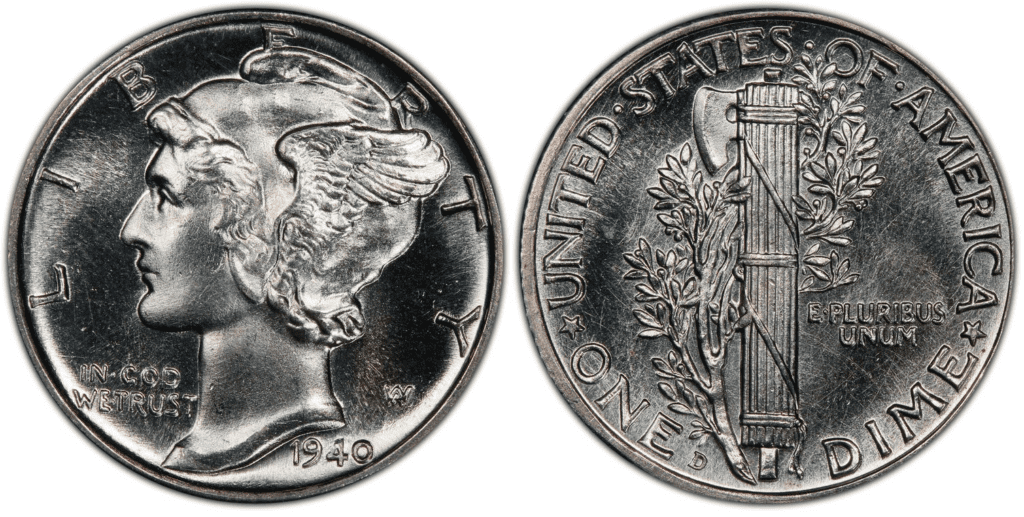
The Denver Mint produced more than 21 million dimes in 1940. This is lower compared to what was produced in 1939 and 1941.
Dimes struck in the Denver Mint were known to be properly struck. They produced a lot of dimes with a Full Bands rating. You should easily find FB examples, but the number drastically drops above MS 67.
1940 S Mercury Dime
Year of minting: 1940
Mint Mark: S
Place of minting: San Francisco
Quantity produced: 21,560,000
Face Value: $0.10 (10 cents)
Price: $2.25 to $6.00 (circulated condition)
Mass: 2.50 grams
Edge: Reeded
Designer: Adolph Alexander Weinman
Composition: 90% silver and 10% copper
Diameter: 17.90 millimeters
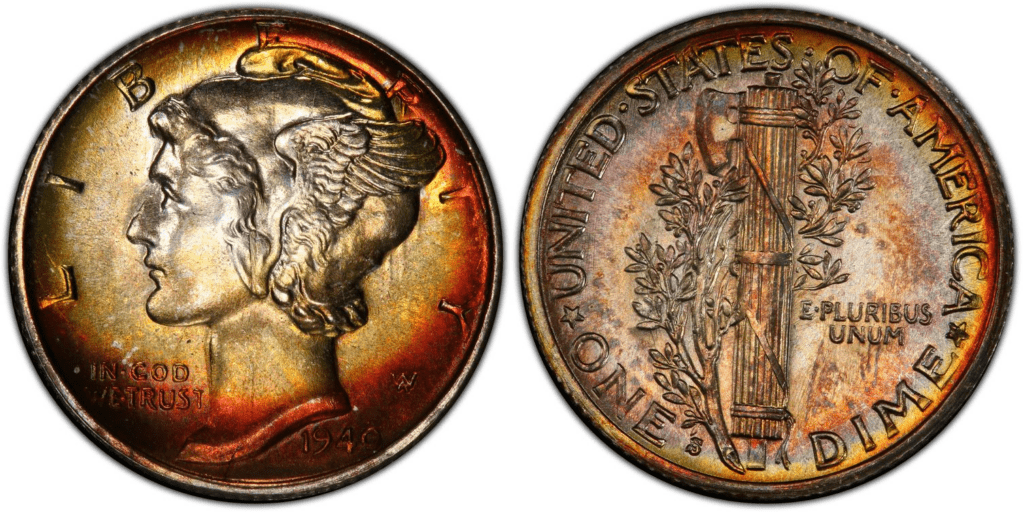
The San Francisco Mint produced a slightly lower number of dimes in 1940 compared to 1939. However, in 1941, you’ll see a drastic increase of up to 175 million dimes.
1940 P Mercury Dime
Year of minting: 1940
Mint Mark: no mint mark
Place of minting: Philadelphia
Quantity produced: 65,350,000
Face Value: $0.10 (10 cents)
Price: $2.25 to $5.00 (circulated condition)
Mass: 2.50 grams
Edge: Reeded
Designer: Adolph Alexander Weinman
Composition: 90% silver and 10% copper
Diameter: 17.90 millimeters
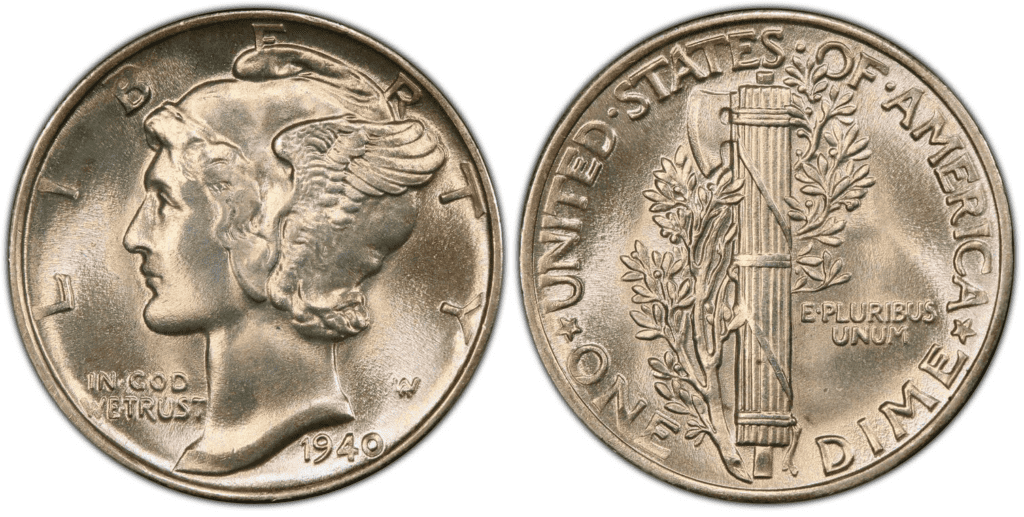
The Philadelphia Mint produced more than 65 million dimes. It is slightly lower compared to the mintage figure in 1939. However, in 1941, you’ll see a drastic increase of up to 175 million dimes.
The Philadelphia Mint was still the number 1 mint center in terms of mintage figures in 1940. It produced the most number of dimes for that year. It is common to find 1940 dimes in all grades up to MS 67. However, it is rare in grades MS 68 and above.
1940 Proof Mercury Dime
Year of minting: 1940
Mint Mark: no mint mark
Place of minting: Philadelphia
Quantity produced: 11,827
Face Value: $0.10 (10 cents)
Price: $110 and above (circulated condition)
Mass: 2.50 grams
Edge: Reeded
Designer: Adolph Alexander Weinman
Composition: 90% silver and 10% copper
Diameter: 17.90 millimeters
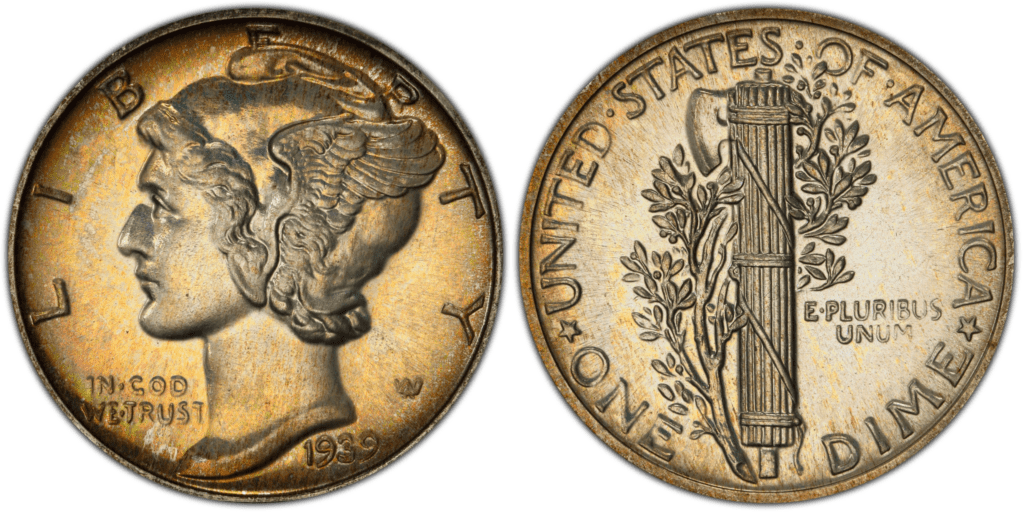
Aside from standard-struck dimes, the Philadelphia Mint also produced proof dime coins. This year, over 11 thousand proof coins were issued, the third-largest mintage figure for proof mercury dimes.
List Of 1940 Mercury Dime Errors
The US Mint does its best to ensure no error coins would ever come out of the mint. However, it seems that error coins are here to stay because, in 1940, Mercury dime errors still existed.
Of course, error coins aren’t all bad news. Many collectors are interested in error coins because they are unique and rare. Sometimes, error coins are even more expensive than normal coins.
So, what are the error coins in 1940 Mercury 10-cent coins? There are a few. One is the repunched mintmark (RPM), more commonly seen in 10 cents produced in the Denver Mint.
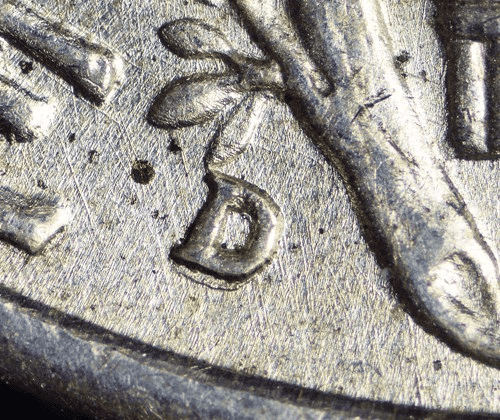
The error happens when the mintmark is struck to the coin twice. Thankfully, the second strike is always almost at the same angle as the previous strike. So, the error isn’t that obvious. However, the more prominent the error is, the more valuable it becomes in the open market.
How Much Is The 1940 Mercury Dime Worth Today?
The 1940 Mercury dime has a face value of 10 cents. It has a melt value of $1.7289, which can increase or decrease depending on the market value of silver.
Looking at the face value or melt value of the 1940 Mercury dime can be disheartening if you have one of these and you’re trying to sell it. If given the right condition, you would be pleasantly surprised to see that the 1940 dime can still be astronomically more valuable than its face value or melt value.
To better understand the value of the 1940 10-cent coin, here’s a table of auction records as detailed by the PCGS website:
| Coin | Condition | Grade | Sold date | Sold by | Value |
| 1940 P Mercury Dime | Superb Gem Uncirculated | MS 68+ (Full Band) | March 21, 2019 | Legend Rare Coin Auctions | $35,250 |
| 1940 S Mercury Dime | Gem Uncirculated | MS 68 (Full Band) | August 6, 2000 | Heritage Auctions | $9,775 |
| 1940 Proof Mercury Dime | Superb Gem Uncirculated | PR 69 | January 12, 2005 | Heritage Auctions | $15,295 |
| 1940 D Mercury Dime | Superb Gem Uncirculated | MS 68 | July 26, 2003 | Heritage Auctions | $3,565 |
As you can see, the 1940 Mercury dime can be very valuable. The coin can be more expensive when sold in the open market.
How Coins are Graded
The Sheldon Scale is used by numismatists to provide a numerical value to coins. The Sheldon Scale goes from poor (P-1) to perfect mint state (P-1) (MS-70). Coins were originally evaluated using words to reflect their condition (Good, Fair, Excellent, Etc.). Unfortunately, coin collectors and dealers had different ideas about what each of these terms represent.
Professional numismatists joined together in the 1970s and established CoinGrading standards. These numismatists now assign grades at key places on the seventy-point scale, using the most regularly utilized numeric points in conjunction with the original adjective grade. The following are the most common coin grades:
- (P-1) Poor – Indistinguishable and probably damaged; if used, must have a date and mintmark; otherwise, rather battered.
- (FR-2) Fair – Nearly smooth, but without the damage that a coin graded Poor often possesses. The coin must have enough detail to be identified.
- (G-4) Fair – Inscriptions have merged into the rims in some areas, and important elements have been mostly erased.
- (VG-8) Very Good- A little weathered, but all of the primary design elements are visible, albeit faintly. There is little if any, central detail left.
- (F-12) Good – The item is very worn, yet the wear is even, and the overall design details stand out clearly. Rims are almost completely isolated from the field.
- (VF-20) Very Fine – Moderately weathered, with some finer features still visible. The motto or all letters of LIBERTY are readable. Both sides of the coin have entire rims that are separated from the field.
- (EF-40) Extremely Fine – Gently used; all gadgets are visible, and the most important ones are bold. The finer details are bold and clear, however, light wear may be seen.
- (AU-50) Uncirculated – Slight evidence of wear on the coin’s design’s high points; may have contact marks; eye appeal should be adequate.
- (AU-58) Uncirculated Choice – Slight traces of wear, no severe contact marks, almost full mint shine, and great eye appeal.
- (MS-60) Mint State Basal – Strictly uncirculated; no indication of wear on the coin’s highest points, but an unsightly coin with reduced luster, visible contact marks, hairlines, and other flaws.
- (MS-63) Mint State Acceptable – Uncirculated, but with contact scratches and nicks, little reduced shine, but otherwise appealing appearance. The strike is weak to average.
- (MS-65) Mint State Choice – Uncirculated with great mint shine, very little contact blemishes, and exceptional eye appeal. The strike is unusually severe.
- (MS-68) Mint State Premium Quality – Uncirculated with superb luster, no obvious contact marks to the naked eye, and exceptional eye appeal. The strike is quick and appealing.
- (MS-69) Almost Perfect Mint State – Uncirculated with perfect brilliance, a sharp and appealing strike, and extremely good eye appeal. A near-perfect coin with minor imperfections in the planchet, strike, and contact markings (seen only under 8x magnification).
- (MS-70) Mint State Perfect – Under 8x magnification, there are no tiny imperfections discernible; the strike is crisp, and the coin is perfectly centered on a beautiful planchet. Rarely seen on a coin, this coin is bright and whole, with original luster and exceptional eye appeal.
Where To Buy Or Sell 1940 Mercury Dime?
You can buy 1940 Mercury dimes in coin shops, antique stores, and pawn shops. Since this is an old coin, you might not immediately find it. However, you can try auction houses where some rarest coins are sold and offered.
Thankfully, living in the digital age means you can also search on the Internet. You can instantly find 1940 Mercury dimes online, especially on eBay and Amazon. Aside from that, you can do a Google search and find numerous websites offering this coin.
The internet is not just a place to buy coins, you can use it to sell your 1940 Mercury dime. For example, you can head to eBay and create your own account. You will then be able to sell your coins.
FAQs
Where is the mint mark on a 1940 Mercury dime?
The mint mark on a 1940 Mercury dime is on the coin’s reverse side. Look for it on the lower tip of the olive branch, near the letter E of the word ONE. If present, you should find an S or D mintmark.
Is a 1940 Mercury dime worth anything?
Yes, the 1940 Mercury dime can be worth a lot of money. While its face value can be just 10 cents, some dimes have been sold for thousands of dollars. If your coin is in good condition and has rare attributes, then you can be sure it has a higher value. Just to give you an idea, one 1940 Mercury dime with a grade of MS 68 was sold for $35,250 in March 2019.
